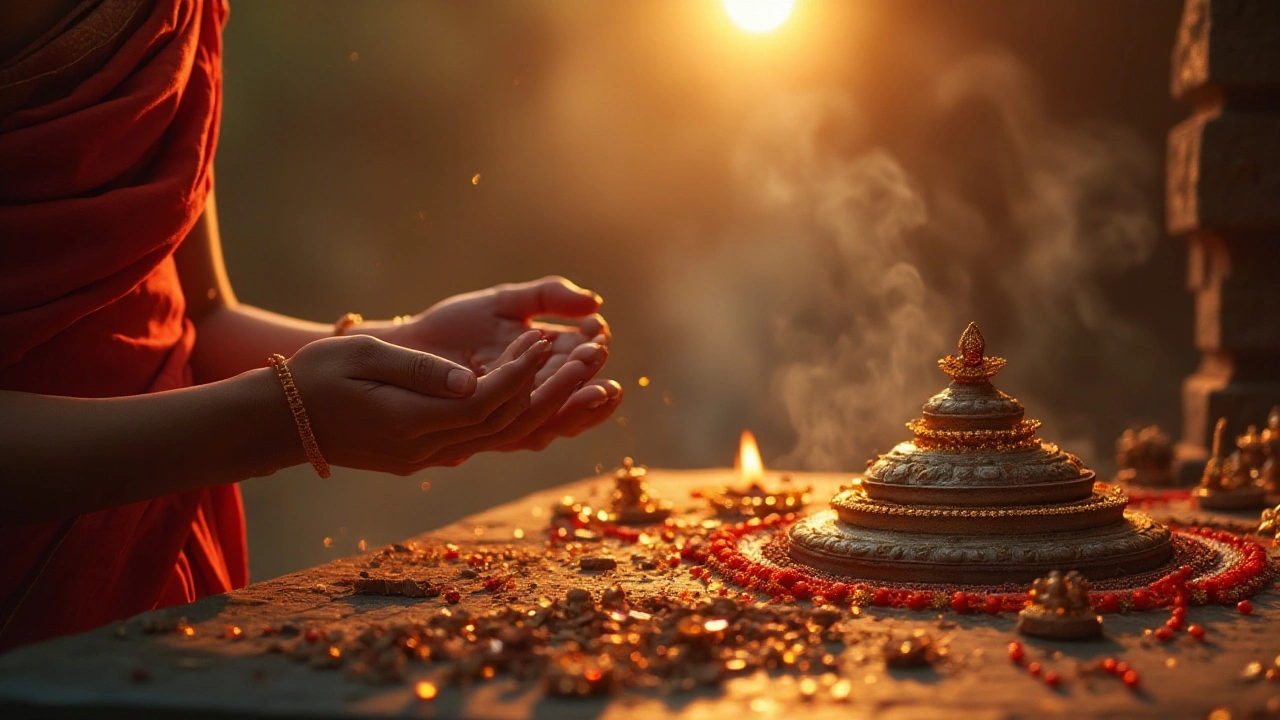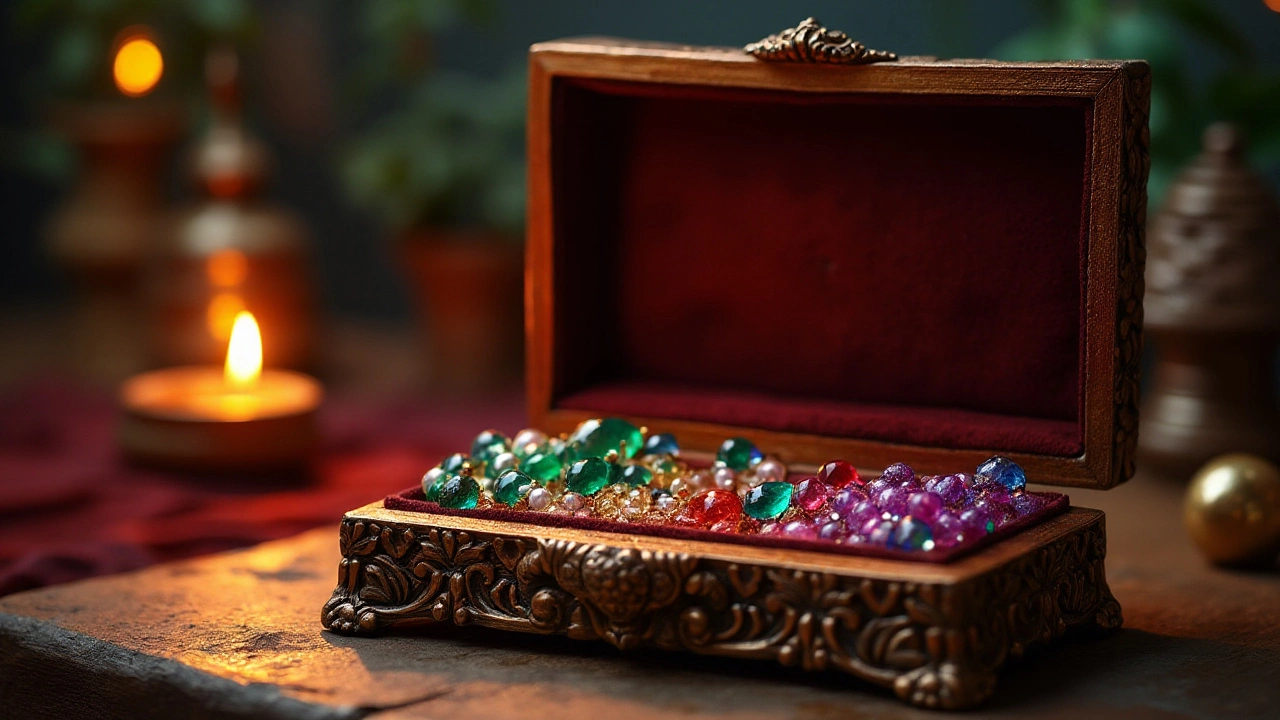Indian temple jewelry is more than just an ornate accessory—it's a bridge to history, spirituality, and culture. Each gemstone adorning these pieces carries its own story, wrapped in the mystique of legends and ancient wisdom. These stones are not chosen solely for their beauty but also for the power they are believed to hold, influencing everything from spiritual energy to personal wellness.
In this exploration, we dive deep into the magical world of these gemstones, uncovering their distinct traits and enduring allure. Prepare to be captivated by the interplay of tradition and modernity, as we unfold the tapestry of the most powerful stones in Indian jewelry, and guide you on how to incorporate this grandeur into your life.
- The Cultural Significance of Gemstones in India
- Commonly Used Stones in Temple Jewelry
- Spiritual and Healing Properties of Gemstones
- How to Choose the Right Stone for You
- Caring for Your Temple Jewelry
The Cultural Significance of Gemstones in India
In the enchanting realm of India's rich traditions, gemstones play a pivotal role, embodying a tapestry of cultural beliefs that stretch back millennia. For centuries, these dazzling jewels have been more than mere decoration; they represent the vibrancy of the Indian way of life, each stone imbued with sacred meaning and power. Across various civilizations in India, such as the great Mauryan, Gupta, and Mughal empires, gemstones were symbols of prosperity, power, and divine protection. The allure of these stones lies not only in their physical beauty but in an inherent spiritual resonance understood to transcend mortal realms, uniting the earthly with celestial.
The traditions surrounding Indian jewelry find their roots in ancient texts and epic narratives such as the Ramayana and Mahabharata. Stories abound of rulers and deities adorned with gemstones, accentuating their divine qualities and regal status. These cultural narratives aren't casual folklore but integral parts of Indian tradition, where sapphires, rubies, and emeralds each possess distinct metaphysical properties, casting their influence over human fate. Temples across India, from the intricate carvings of Khajuraho to the solemn expanse of Varanasi's ghats, often house idols that are resplendently adorned in gemstone-studded ornaments. This sacred confluence of art and spirituality invites devotees to engage with the divine through the tangible beauty of temple jewelry.
Historical Relevance and Spiritual Lore
Historically, gemstones have been used as amulets against evil, conduits of healing, and focal points in rituals across Indian culture. The Navaratna, a revered arrangement of nine gemstones, represents various facets of Vedic astrology and is believed to harness planetary energies to bestow balance and protection upon the wearer. Each of these stones — from the enchanting blue sapphire to the fiery coral — is a celestial powerhouse in its own right, carefully chosen to enhance life according to astrological charts. An ancient Indian saying encapsulates this belief: "He who wears the Navaratna governs the universe," underscoring the supreme aspect ascribed to these jewels.
"The significance of gemstones in Indian culture extends beyond mere ornamentation. They are vessels of cosmic energy, linking human hearts to divine force," notes Dr. Bhattacharyya, a historian specializing in South Asian studies.
This profound belief in the transformative power of stones persists in contemporary India, where gemstones continue to influence personal and spiritual well-being. Whether set in intricate temple jewelry or worn for individual reasons, these stones frequently serve as personal talismans, cherished across generations. It is a legacy that seamlessly marries ancient customs with the lived realities of modern India, ensuring that these stones remain not just relics of the past but vibrant parts of daily life, rich with historical echoes and spiritual aspirations.
Thus, the cultural tapestry woven by gemstones in India is vibrant and multi-dimensional, encompassing art, spirituality, and identity. Their allure narrates the saga of a civilization that has long revered beauty and spirituality as intrinsic, transformative aspects of human life, compelling us to look beyond the material and touch the ethereal through the simplest, yet profound, embodiments of natural wonder.
Commonly Used Stones in Temple Jewelry
In the vibrant and spiritually charged realm of Indian temple jewelry, specific gemstones consistently find their place due to their aesthetic appeal and the profound meanings they carry. One of the most revered stones in this category is the ruby. Known as the 'ratnaraj' or the king of precious stones in Sanskrit, rubies have long been associated with power, passion, and protection. These crimson gems are believed to provide clarity and focus, helping the wearer develop a strong sense of self. They are often used in temples because they symbolize the Sun, expressing vital life force and nobility. Additionally, rubies are a preferred choice for honoring deities like Lord Vishnu and Goddess Lakshmi, emphasizing its sacred essence in religious and cultural practices.
Next up is the mesmerizing emerald, renowned for its lush green hue that captivates the eye and soul alike. Emeralds are not just famous for their beauty but are also considered powerful stones for enhancing intellectual growth and memory. Historically, these stones were cherished by Vedic astrologers who believed they improve communication and inspire harmony in relationships. In temple jewelry, emeralds often complement gold settings, symbolizing peace and fertility. Their spiritual significance is profound, with many believing that they are connected to the heart chakra, capable of radiating unconditional love. Unsurprisingly, the allure of emeralds in India dates back centuries, with Mughal emperors treasuring them for both adornment and their supposed divine connection.
Another cornerstone in the world of temple jewelry is the sapphire, particularly captivating in blue but cherished in other colors too. The strong, deep blues of sapphires represent wisdom, virtue, and spiritual insight. This stone is believed to activate the third eye and throat chakras, allowing the wearer to channel inner vision and articulate thoughts clearly. Sapphires feature prominently in the embellishment of idols and royal attire alike, thereby solidifying their presence in both religious and regal contexts. The stone’s reputation for grounding and calming energies makes it particularly sought after by those seeking mental resilience and protection against negative spiritual influences. Historical texts describe the ways in which faithful followers would include sapphires in their temple offerings, symbolizing their devotion and desire for enlightenment.
The diamond, unsurprisingly, claims an exalted spot in the realm of temple jewelry. Valued as the 'vajra' or the most potent and enduring substance known to humankind, diamonds are symbols of indestructibility and purity. While these precious stones are often associated with wealth and luxury, their spiritual significance runs deep, symbolizing strength and eternal bonds. Diamonds are regarded as powerful amplifiers of energy, believed to further the intensity of divine connection during meditation or prayer. In historical accounts, diamonds were often used to adorn statues of gods and goddesses, serving as a testament to their enduring place in spirituality. As Gandhi once suggested, 'The diamond in the heart of the earth is the symbol of faith, like the purest form of love.'
Carl Jung once remarked, "A particularly beautiful woman is a source of terror. As a rule, a beautiful woman is a terrible disappointment."The same can be said about diamonds in temple jewelry—beyond their beauty lies a profound symbolism that elevates one’s spiritual journey.

Spiritual and Healing Properties of Gemstones
The mystique and allure of gemstones have captivated humans for centuries, transcending cultures and traditions. In India, these gemstones are not just pieces of aesthetic jewelry; they are meant to align energies and support spiritual journeys. Wearing gemstones is deeply rooted in ancient Indian practices, with each stone resonating with different vibrations and energies. Temple jewelry often includes stones like ruby, sapphire, emerald, and diamonds—each resonating with powerful spiritual and healing properties. The ruby, known in ancient Sanskrit as 'Manikya,' is associated with the Sun, offering warmth, ambition, and vitality. Individuals have believed it to enhance leadership qualities and creativity while also bringing about vigor. Rubies are also said to protect against negative energies, providing a strong shield for the wearer’s aura and attracting stability and prosperity.
Equally fascinating is the emerald, or 'Panna,' revered for its vibrant green hue. It’s not just its allure that makes it stand out; it’s believed to be a stone of courage and protection. Emeralds are thought to possess the power of providing mental clarity, improving intellect, and enhancing decision-making abilities. Historically, they have been linked to the planet Mercury, influencing communication and business acumen. The lore suggests that wearing an emerald can calm the mind and provide solace in times of unrest, bringing balance to emotions and promoting harmony within the soul.
Sapphires, particularly the blue ones, hold a distinct place in Indian traditions as well. Known as 'Neelam,' the blue sapphire is associated with the planet Saturn. It is often considered a stone of powerful, protective abilities, which have the strength to block negative thought patterns and encourage self-discipline. For those inclined towards spiritual growth, the blue sapphire aids in illumination, bringing deep meditation and insight. In astrology, it is recommended to consult with an expert before wearing a sapphire since its effects can be profound, and it might not harmonize with every individual’s energy.
Inclusion of gemstones like diamonds in temple jewelry serves various purposes. Beyond the undeniable aesthetic appeal, diamonds are attributed with enhancing individual strengths. Known for their clarity and invincibility, they symbolize abundance and attract positive energies. Supporters of crystal healing extol that diamonds can amplify the energy of other gemstones, adding brilliance to personal charisma and enriching life with joyous vibrations.
Renowned gemologist Judy Hall once remarked, "Each gemstone is a conversation waiting to happen. How they affect your energy is as varied as individual soul paths." With this profound observation in mind, choosing the right gemstone becomes a personal journey of exploration and self-discovery. Wearing a specific gemstone is often compared to engaging in a silent dialogue with oneself, where the stone becomes a catalyst to tap into latent potential and hidden desires.
The spiritual benefits of these gemstones can often extend into realms that impact one’s health. Crystal therapy is an age-old practice that harnesses the healing properties associated with these stones. Advocates insist that by placing gemstones near the body, healing vibrations can relieve physical ailments, from digestive issues to emotional imbalances. Although empirical evidence varies, an increasing number of people find peace and wellbeing through such practices.
How to Choose the Right Stone for You
Choosing the right gemstone in the grand tapestry of Indian temple jewelry can feel overwhelming, given the rich diversity of stones available. The journey begins with understanding your personal aspirations and what you hope the powerful stones will bring into your life. Whether you seek spiritual enlightenment, prosperity, or healing, recognizing these intentions helps in selecting a stone that aligns seamlessly with your desires. An essential step in this process is to learn about the properties of various gemstones, as each stone carries its own unique vibrational energy. For instance, if you are in pursuit of tranquility and peace, you might be drawn to Blue Sapphire known for its calming influence and protection against negative energies. Meanwhile, if abundance and prosperity are your goals, Emerald is celebrated for attracting wealth and enhancing communication.
A fascinating aspect of choosing the right stone involves the ancient science of Vedic astrology, or Jyotish, practiced widely in India. This tradition asserts that the planetary positions at the time of your birth play a significant role in shaping your life's journey. “A gemstone should harmonize the planetary energies to bolster your strengths and alleviate challenges,” suggests Thiru G. Jain, a revered astrologer in Chennai.
“Balance is key, as each gem interacts with the cosmos in profound ways.”Engaging with a learned astrologer or gemologist before making a decision could provide insight into the types of stones that might best support your astrological profile.
When selecting the right stone, it is equally vital to consider authenticity and quality. The integrity of a gemstone directly affects its potency. Always source stones from reputable jewelers who can provide a certificate of authenticity, ensuring you benefit from its full potential. Be wary of imitations, many of which flood markets. Genuine stones are tested for their origin and properties, and a credible dealer will offer transparency regarding these aspects. In addition, pay attention to the cut of the stone; a well-cut gem not only enhances its natural beauty but also aids in maximizing its energetic influence.

Caring for Your Temple Jewelry
Preserving the splendor of your Indian jewelry involves more than just wearing it with pride. Proper care is essential to ensure longevity and maintain its stunning appearance. Given the intricate work and the use of potent gemstones, understanding how to care for these pieces becomes crucial. The beauty of temple jewelry often derives from its complexity, and this means being attuned both to the materials used and to the craftsmanship that brings them together. Each piece tells a story, not just in the aesthetics but through the choice of stone and metal, with cultural significance dating back centuries. It's important to store them separately, perhaps wrapped in a soft cloth or kept in a lined box, to avoid any scratches from harsh surfaces or other jewelry. They can be surprisingly delicate despite their robust appearance.
Regular cleaning is vital but should be approached with care. Avoid modern chemical cleaners that might harm the delicate finishes or fade the gemstones. Instead, consider a mixture of mild soap and warm water. Gently scrubbing with a soft brush can remove dirt and oils accumulated through wear, without damaging the metalwork or stones. It's equally important to promptly dry the jewelry to prevent any tarnishing of the metals. Professional cleaning might be considered occasionally to maintain the highest shine and allure—it's often worth the investment for these timeless pieces. Be cautious when wearing your temple jewelry during activities that might expose them to sweat, dust, or cosmetics, as these can all dull their shine.
"Jewelry should not just shine in the cases but dazzle in our memories," once commented famed jeweler L.V. Prasad, highlighting the importance of care in preservation.
Knowing the specific traits of different gemstones can greatly enhance your care routine. Some stones, for example, are sensitive to sunlight or extreme temperatures, which might alter their color or even cause cracks. Thus, wearing such pieces should be considerate of the environment. It's wise to check the settings regularly to ensure stones are secure, as even minor damage can loosen them. Jewelry insurance might sound like a modern concept, but for treasured pieces like temple jewelry, it could be a savvy choice to protect against loss or damage. Taking such precautions ensures these heirlooms endure, safeguarding them for future generations to enjoy and cherish.
Tips to Extend the Life of Your Jewelry
- Store pieces separately to avoid scratches.
- Use mild soap and warm water for gentle cleaning.
- Avoid exposure to direct sunlight and extreme temperatures.
- Consider professional cleaning for a thorough polish.
- Insurance for valuable pieces might be worthwhile.
Whether worn for special occasions or daily inspiration, temple jewelry serves as a reminder of a rich tradition, imbued with symbolic meaning and history. By investing time and thought into its care, you are not only ensuring its physical survival but also preserving the stories and sentiments each piece carries. Each maintenance step becomes a ritual, binding past and present, while safeguarding its splendor for the future. Remember, your jewelry is not just an embellishment—it's a piece of living history and culture that's worth maintaining with dedication and love.



